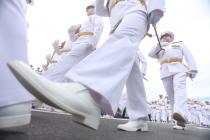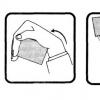Lecture 11
Superclass Pisces
Subtype characteristic
Animals of the subtype Vertebrates are divided into two groups: primary aquatic - anamnia and primary terrestrial - amniotes. Anamnias include cyclostomes, fish and amphibians, the development of their embryos occurs in the aquatic environment, they lack embryonic membranes. Amniotes with embryonic membranes (amnion, chorion, allantois) include reptile birds and mammals. The total number of living vertebrates reaches 40,000 species. covers . The skin is characterized by a multi-layered epidermis and a well-developed dermis (corium, or cutis), subcutaneous fatty tissue develops in the depths of the dermis. The epidermis develops sebaceous and sweat glands and other glands. The epidermis gives rise to horny formations - horny scales, feathers, hair, nails, etc. The epidermis is of ectodermal origin, the dermis is mesodermal. Skeleton and muscles . In the vertebrate embryo, the skeleton is represented by a notochord surrounded by a connective tissue membrane. Cartilaginous or bony vertebrae of the spine are subsequently formed from it, and the skeleton of the head is formed in the anterior part. The skeleton of the head consists of the brain section and the facial (visceral) sections, which include the gill arches and their derivatives. The fish already had jaws (from gill arches), which made it possible to capture and hold large prey. In adult vertebrates, the notochord is preserved only in cyclostomes and some lower fish. Limbs are formed. The origin of the limbs is associated with metapleural folds, which first gave rise to a number of paired fins, then there was an increase in the anterior and posterior fins and a reduction in the intermediate ones. The muscular system in lower vertebrates has a segmental structure, in higher ones there is no segmentation; in connection with the appearance of jaws and limbs, a mobile type of connection of bones is formed - with the help of joints. Muscles responsible for movement in the joint are antagonists, flexors and extensors. Nervous system subdivided into central and peripheral. The central nervous system is formed by a well-developed brain and spinal cord. The brain is laid in the form of three bubbles - anterior, middle and posterior, anterior and posterior are further separated and five sections of the brain are formed: anterior, intermediate, middle, cerebellum and oblong. In the brain there are cavities - cerebral ventricles connected to the spinal canal. The peripheral nervous system is anatomically represented by nerve ganglia, cranial and spinal nerves. Anamnias have 10-11 pairs of cranial nerves, while amniotes have 12 pairs. Physiologically, the peripheral nervous system is divided into autonomous, regulating the work of internal organs, and somatic, regulating the contraction of skeletal muscles. An active lifestyle led to a good development of the organs of vision, hearing, and smell. The organs of taste and touch are traditionally well developed. Primary aquatic vertebrates have a special sense organ - the lateral line. Digestive system . There is a further differentiation of the digestive system into the following sections: oral cavity, pharynx, esophagus, stomach, small and large intestines. The digestive glands are developed - the liver and pancreas, opening into the anterior section of the small intestine - the duodenum. Respiratory system . The organs of water respiration are gills and skin; in terrestrial animals, in connection with breathing atmospheric air, lungs develop from the pharyngeal pockets. Circulatory system vertebrates is closed, in cyclostomes, fish and amphibian larvae one circle of blood circulation and venous blood enters the two-chamber heart, which then goes to the gills through the abdominal aorta. In adult amphibians, reptiles, birds and mammals, lungs and a second circle of blood circulation appear - pulmonary. In the heart, depending on the level of organization, there is different number cameras. Amphibians have two atria and a ventricle; in reptiles, an incomplete septum appears in the ventricle; the right and left aortic arches depart from the ventricle. In birds, the septum is complete and only the right aortic arch is preserved; in mammals, there is also a complete separation of arterial and venous blood by a complete septum in the heart, but the aortic arch is left. excretory system represented by paired kidneys. In fish and amphibians, the head kidneys, or pronephros (pronephros), function at the larval stage. They are represented by a large number of excretory tubules, which open with funnels (nephrostomas) into the body cavity, other openings of the tubules open into the common excretory duct (Fig. 137).
Rice. 137. Scheme of the structure of the kidneys of vertebrates
1 - dorsal aorta; 2 - external malpighian glomerulus; 3 - malpighian glomerulus in Bowman's capsule; 4 - funnels of the tubules of the head and trunk kidneys; 5 - hindgut; 6 - Muller channel; 7 - head kidney; 8 - trunk kidney; 9 - pelvic kidney; 10 - duct of the trunk kidney; 11 - secondary ureter; 12 cloaca.
Next to the nephrostomy are capillary glomeruli (Malpighian glomeruli), from which the blood plasma with metabolic products enters the abdominal fluid and then, through the nephrostomy, into the excretory tubules. In adult fish and amphibians, posterior to the pronephros, trunk buds are laid - mesonephros (primary buds). The internal structure of the mesonephros differs in that a protrusion (Bowman's capsule) is formed next to the nephrostomy, in which the capillary glomerulus is found. Such a formation is called the Malpighian body, and together with the excretory tubule - the nephron. Primary kidneys contain up to several hundred nephrons. Some nephrons retain their connection with the coelom through funnels, while others lose this connection. In reptiles, birds and mammals, secondary kidneys are formed - metanephros, or pelvic kidneys. Their renal tubules do not have nephrostomes and begin with a Malpighian body, i.e. Bowman's capsule and capillary glomerulus. Reabsorption (reabsorption) of water, vitamins, glucose, amino acids, hormones, salts occurs in the tubules. As a result, the amount of urine excreted decreases, but the concentration of dissimilation products sharply increases in it. Reproduction and development . Vertebrates are usually dioecious. Hermaphroditism, as a normal condition, is present in a small number of lower vertebrates. Phylogeny . Vertebrates appeared in the Paleozoic era in the Silurian period, in the Devonian period the first amphibians came to land, in the Carboniferous period reptiles appeared. In the Mesozoic era, mammals (animals) and birds appear. Aromorphoses. 1. Vertebrates are characterized by active movement, in connection with this, the tail develops strongly in most aquatic; paired limbs appear - pectoral and ventral fins. 2. The spine is formed, the basis of a strong and flexible internal skeleton. 3. In terrestrial vertebrates, paired fins have evolved into fore and hind limbs. Paired limbs are absent only in animals of the superclass Jawless. 4. An active lifestyle leads to the complication of the brain, digestive, respiratory and excretory systems, the formation of the jaw apparatus. 5. Amniotes include reptiles, birds and mammals, the development of eggs and embryos of which occurs inside the egg or in the mother's body in special embryonic membranes - amnion, chorion, allantois. Embryonic membranes perform protective functions and ensure the metabolism of the embryo. 6. In addition to the embryonic membranes, egg membranes are formed. They additionally provide the developing fetus with the necessary organic and inorganic substances, perform protective and respiratory function.
Superclass characteristic
The superclass Fish includes more than 20,000 species of fish, of which about 700 species belong to the class Cartilaginous fish, the rest are grouped into the class Bony fish. Covers. The body is usually covered with scales, which performs a protective function. Skeleton and muscles . The skeleton is cartilaginous or bone, consists of the following sections: the skull, the skeleton of the spine, the skeleton of the limbs and the skeleton of the limb belts. Jaws, gill apparatus appear in the skull, paired limbs and limb girdles appear, a spine is formed, consisting of individual vertebrae. The muscles of the trunk retain a metameric structure. Digestive system . For cartilaginous fish, a characteristic feature is the presence of a spiral valve in the intestine, the intestine opens into the cloaca. Bony fish do not have a cloaca (except lungfish). For the first time, a morphologically pronounced pancreas appears. The most advanced fish develop a swim bladder, like an outgrowth of the intestine, which helps regulate body density and associated buoyancy. Respiratory system . The respiratory organs are represented by gills, cartilaginous fish have intergill septa, on which the gill petals are located. In bony fish, the gill filaments are attached to the gill arches, gill covers appear. Circulatory system consists of a two-chambered heart and one circle of blood circulation (except lungfish). Blood enters the atrium from the venous sinus, from the ventricle it is ejected into the arterial cone (in cartilaginous fish) or into the aortic bulb (in bony fish). excretory system represented by trunk kidneys. The main product of nitrogen metabolism in cartilaginous fish is urea, in bone fish - ammonia. Nervous system . Central nervous system - the brain, consisting of five sections and the spinal cord, located in the spinal canal; The peripheral nervous system is represented by cranial and spinal nerves. Reproduction and development . Fish, as a rule, are dioecious organisms. Cartilaginous fish lay eggs, some live birth. Bony fish spawn a large amount of small caviar, there are ovoviviparous species. The main aromorphoses that allowed fish to dominate the seas and oceans for a long time are as follows. 1. The first gill arches turned into jaws capable of capturing large prey. 2. Paired fins appeared - pectoral and ventral, which provided more precise and complex movements in a dense aquatic environment. 3. The notochord was replaced by a cartilaginous, and then by a bone spine, which effectively performs protective and supporting functions. 4. Formed a skull that protects the brain. 5. Respiratory organs became more complicated, gills appeared, which increased the surface and intensity of gas exchange. 6. The liver has become larger, the pancreas has formed. Enlargement of the inner surface of the intestines led to more complete digestion and absorption nutrients. Phylogeny . In the Ordovician - Silurian of the Paleozoic era, the predecessors of fish appeared - skullless, then jawless, then armored fish. The oldest vertebrates jawless, or shield. Modern cyclostomes are similar to scutes due to the absence of jaws and paired limbs, a sucking mouth, and a number of other features, which made it possible to combine them into one superclass Jawless. The earliest jawed animals are armored fish whose body was covered with a bony shell. The first cartilaginous and bony fish appeared about 350 million years ago. Class Cartilaginous fish (Сhondrichtyes) They have a number of features that allow them to be singled out in a separate class. Their skeleton is cartilaginous, but the notochord remains and passes through holes in the vertebral bodies. Gill covers are absent, gill slits in the amount of 5 - 7 pairs open outward each with an independent opening. The pectoral and ventral fins are horizontal, the swim bladder is absent. Cartilaginous fish include sharks (about 250 species), rays (350 species) and a small group of whole-headed or chimaeras (about 30 species). The body size of sharks is from 20 cm to 15 - 20 meters, the largest stingray - manta rays - reaches a mass of up to 3 tons and a span of fins up to 8 meters. The survival and progressive development of cartilaginous fishes is largely facilitated by the peculiarities of their reproduction. Cartilaginous fish are characterized by internal fertilization. Some of them lay large eggs covered with a strong horny shell that reliably protects the developing embryo. Often eggs resemble a pillow, from the corners of which long cords extend, with the help of which the egg is held by algae. Whale shark eggs - 63 by 40 centimeters! In other cartilaginous fish, eggs are not laid, they linger in special expansions of the oviducts, and young sharks are “born” twice - first they leave the egg, then from the mother’s body. This reproduction is called ovoviviparity. Young animals emerge as large and active predators. Moreover, already in the mother's body, they often devour their smaller counterparts and still unfertilized eggs. In still others, a real live birth is observed, that is, the embryos develop in the expansion of the oviducts - a kind of "womb", they feed with the help of the "umbilical cord" and "placenta", all nutrients are obtained from the mother's body. The largest sharks are whale (up to 20 meters) and giant (up to 15 meters), but they do not pose a danger to humans, because. They feed on planktonic organisms and small fish. The most dangerous for humans are the white shark - carcharodon (aka cannibal shark), whose body size is up to 8 meters, the tiger shark and the mako shark, but about fifty species are currently considered potentially dangerous. Class Bony fish (Osteichtyes) The skeleton is always bony, the gill septa are reduced, the gill filaments sit on the bony gill arches, and the gill apparatus is covered by gill covers from the outside. There is a swim bladder, which is located in the upper part of the body cavity; in primitive species, it maintains a connection with the digestive system for life. With the help of the swim bladder, fish change their body density when diving or surfacing. The body is covered with scales or naked. Fertilization in the vast majority is external, they lay small eggs, without corneas. The class Bony fish unites more than 20 thousand species of fish and is divided into two subclasses: the subclass Lobe-finned and the subclass Ray-finned. Subclass Lobe-finned includes two superorders - Crossoptera and Lungfish. Amphibious animals originated from freshwater lobe-finned fish in the Carboniferous period of the Paleozoic era. In the future, the crossopterygians switched to life in the sea. It was believed that the Loop-finned fish became extinct in the Mesozoic era, but in 1938 the first specimen of a coelacanth fish, called coelacanth, was caught in the Indian Ocean. The size of the fish reaches 180 cm, body weight up to 95 kg, this is the only representative of a remarkable group of animals that has survived to our time. Coelacanth reproduces with the help of ovoviviparity, eggs weighing up to 300 g remain in the oviducts for a whole year, then small coelacanths are born. D

The bark-breathers appeared in the Devonian period of the Paleozoic era. A characteristic feature is the presence of one or two lungs for breathing atmospheric air. In connection with the appearance of the lungs, the second circle of blood circulation appears - the pulmonary. Four species of protopteres and one species of the genus Lepidosirens are classified as two-lungs. Subclass Ray-finned Fish are divided into the superorder Ganoid and the superorder Bony fish. Ganoid - an ancient group of fish that has retained a number of primitive features. Sturgeons have a rostrum and a transverse mouth on the underside, a heterocercal caudal fin, and horizontal paired fins. Their notochord persists throughout their lives, there are no vertebral bodies, a spiral valve remains in the intestine, and an arterial cone in the heart. The scales are thick, covered with an enamel-like substance - ganoin. But along with the ancient signs, signs characteristic of higher fish appeared: the bone parts of the skeleton appeared - bone gill covers, the cartilaginous brain skull was covered with skin bones on the outside; gill covers that protect the gills and play the role of a water-pumping apparatus; a swim bladder that regulates the body density of fish at different depths; fertilization in the majority is external, because fish lay a very large amount of small caviar that does not have a horn shell. Ganoid fish include Sturgeon or Cartilaginous ganoids. Sturgeons are characterized by the presence of five rows of bony plates (scutes), one on the back and two pairs of rows on the sides of the body; ganoid scales are located on the sides of the upper lobe of the heterocercal caudal fin. The largest representatives of the sturgeon order are beluga and kaluga. Beluga is common in the basins of the Caspian, Black and Azov Seas, reaches a length of 4 - 5 m, the mass of such specimens is more than 1 ton. Kaluga lives in the Amur basin and reaches a size of up to 3.7 m and a weight of 380 kg. Russian sturgeon has the largest number among sturgeon, its size is up to 230 cm and weighs 80 - 100 kg. Sterlet is a freshwater fish, but in the Volga basin there is also a semi-anadromous form, which is up to 74 cm long and weighs 2.8 kg. Sturgeons were originally probably freshwater fish, this is evidenced by their reproduction in fresh water, subsequently many of them switched to a migratory lifestyle. Superorder Bony fishes. These include about 90% of all modern fish. Their caudal fin is equally lobed, the skeleton is bony. The swim bladder serves as a hydrostatic organ; it may be absent in bottom species and in some predators, good swimmers. In some fish it is used as an additional respiratory organ. covers . The skin is made up of the epidermis and dermis. The dermis of most fish forms scales. Bone scales, consists of thin bone plates. The growth of the scales occurs unevenly, annual rings are formed, by which the age of the fish can be determined. The epidermis secretes mucus, which reduces friction against water. The color of the fish is patronizing, the back of the majority is colored darker, the belly is silvery. Skeleton bone. The spine is formed by biconcave vertebrae, between which remains of the notochord are preserved. The vertebrae of the trunk region have an upper arch and an upper process, ribs are attached to them from below (Fig. 138). In the caudal region, the vertebrae have superior, inferior arches, and spinous processes. The skull consists of the brain and facial sections. The facial section is represented by the jaws, the hyoid arch and the gill apparatus. Gill arches have gill rakers that filter water, gill covers actively pump water through the mouth and gills. The skeleton of the fins is represented by bone rays, the girdle of the forelimbs is connected to the skull, the girdle of the hind limbs is in the musculature. In addition to paired fins - pectoral and ventral, there are unpaired fins - dorsal and anal (Fig. 139).

Rice. 139. Fish Skeleton:
1 - spinous processes of the vertebrae; 2 - lower arches of the vertebrae; 3 - lower spinous processes of the vertebrae; 4 - ribs; 5 - muscle bones; 6 - the main bones of the rays of the fins; 7 - rays of fins; 8 - bones of the shoulder girdle; 9 - bones of the pelvic girdle; 10 - skull.

Rice. 138. Fish spine:
1 - vertebral body; 2 - superior spinous process; 3 - ribs; 4 - the remains of the chord; 5 - spinal cord; 6 - dorsal aorta; 7 - left and right veins.
Digestive system . The teeth are conical, located on the jaws and palatine bones, cyprinids have no teeth, but on the last pair of gill arches there are bone outgrowths - pharyngeal teeth. In planktivorous gill rakers form a filtering apparatus. The pharynx and esophagus lead to the stomach, followed by the small intestine, which in many species has blind processes. They increase the absorptive surface of the intestine. The ducts of the liver open into the small intestine; the pancreas is scattered in islets over the mesentery. The large intestine ends at the anus. D

Rice. 140. Gill rakers of bony fishes. A - planktivorous fish; B - predatory:
1 - gill arches; 2 gill rakers; 3 - gill petals.
Most bony fish have a swim bladder. Open-bladder fish keep the connection of the swim bladder with the esophagus all their lives, in closed-bladder fish this connection is lost. The swim bladder maintains a connection with the esophagus for life in fish of the order Herring-like, Salmon-like, Pike-like, Eel-like, Cyprinidae; from the superorder Ganoid - the orders Sturgeon, Multi-feathered, Amie-like, Armor-shaped. From the subclass of the Lobe-finned - the superorder Lungfish. Closed-bladder fish include all perch-like (perch, pike-perch, ruff) and mullet-shaped. Do not have floating

Rice. 141. Scheme of the structure of the heart of fish.
A - the heart of cartilaginous fish, B - the heart of bony fish:
1 - venous sinus; 2 - atrium; 3 - ventricle; 4 - arterial cone with valves (reduced in bony fish); 5 - aortic bulb. some deep-sea fish, many flounders, as well as fish that quickly change the depth of swimming - tuna, mackerel. Respiratory system . There are no intergill septa, and on the gill arches (4 pairs) there are bony gill rakers and gill filaments (Fig. 140), in the walls of which capillaries pass. With the help of the mouth and gill covers, water is pumped through the gills, in which gas exchange occurs. In addition, the gills play an important role in the regulation of the osmotic pressure of the blood of fish. Circulatory system closed, one circle of blood circulation, two-chamber heart (Fig. 141) and consists of a thin-walled atrium and a muscular ventricle. Venous blood is first collected in the venous sinus - an expansion that collects blood from the venous vessels, then enters the atrium and is pushed out of the ventricle. Between the atrium and the ventricle there are valves that prevent blood from returning to the atrium. From the ventricle, blood enters the enlarged initial part of the abdominal aorta (aortic bulb). From the heart, venous blood passes through the abdominal aorta to the gills, arterial blood is collected in the dorsal aorta. Blood moves to the head and front of the body through the carotid arteries, to the back of the body - through the unpaired dorsal aorta, which runs under the spine. From all organs, venous blood through the vessels enters the common venous sinus.

Rice. 142. The structure of the fish:
1 - gills; 2,4 - anterior and posterior cardiac veins; 3 - Cuvier duct; 5 - dorsal aorta; 6 - trunk kidney; 7 - swim bladder; 8 - bladder; 9 - urinary opening; 10 - sexual opening; 11 - anus; 12 - ovary; 13 - spleen; 14 - gut; 15 - stomach; 16 - blind outgrowths of the intestine; 17 - liver; eighteen - gallbladder; 19 - venous sinus; 20 - heart; 21 - aortic bulb; 22 - abdominal aorta.

Rice. 143. Fish brain:
1 - forebrain; 2 - midbrain, visual lobes; 3 - cerebellum; 4 - medulla oblongata; 5 - olfactory nerve.
excretory system . Fish have paired trunk kidneys, which are located in the body cavity above the swim bladder (Fig. 142) - dark red ribbon-like formations that fit snugly to the spine. Purified blood returns to the circulatory system through the renal vein, metabolic products through the ureters enter the bladder and through the urinary opening are excreted. Nervous system . The cerebral hemispheres are responsible only for the sense of smell, there is no nerve substance in the roof of the brain. The diencephalon is small. The midbrain has optic tubercles and is well developed. The cerebellum develops depending on the degree of mobility of the fish. The medulla oblongata passes into the spinal cord (Fig. 143). 10 pairs of cranial nerves depart from the brain. This structure of the brain provides the formation of conditioned reflexes and the complex behavior of fish. During their life, they easily form reflexes to visual, auditory, olfactory stimuli. The spinal cord runs in the spinal canal of the spine. The eyes have a flat cornea and a round lens. Accommodation is carried out due to the movement of the lens relative to the retina. Most fish see well at a distance of up to 1 m, but some - up to 10-12 m. Fish hear well and are able to make sounds. They "talk" among themselves with the help of a swim bladder, with the help of sounds made by gill covers, jaws, teeth, friction of fins. The inner ear is a membranous labyrinth with three semicircular canals; the snail, characteristic of terrestrial vertebrates, is still missing. Taste organs are represented by taste buds, which are located in the oral cavity and on the surface of the body. A characteristic lateral line is a channel that runs along the sides of the body and communicates with the external environment through holes passing through the scales. At the bottom of the channel are receptors that perceive subtle changes in water pressure. This helps to navigate in the dark, to feel the approach of other inhabitants of the water and underwater objects. Reproduction and development . The fish are dioecious, hermaphroditic species are extremely rare. Females develop paired ovaries, while males develop testes. In hermaphrodites, the gonads function either as testes or as ovaries, so self-fertilization does not occur. In a fertilized egg, the embryo develops. The development of fish occurs with transformation, a larva emerges from the egg, which does not feed for some time, using the nutrient reserves of the yolk sac, then proceeds to active feeding. Usually river fish to spawn they rise up the river, closer to the places where they themselves appeared. Anadromous fish (fish that live in the seas and oceans, and spawn in rivers) gather in large flocks and go to spawning sites, overcoming great distances. In most fish, fertilization is external, and enormous fecundity is characteristic, when the female spawns hundreds of thousands of eggs (cod female - up to 10 million, moon-fish - up to 300 million). The less eggs are laid, the more developed care for offspring. For example, a three-spined stickleback male builds a ball-shaped nest with two holes from aquatic plants, females lay several dozen eggs, and the male guards the nest for about 2 weeks, attacking even large fish. Near the nest, it is located in such a way that with its pectoral fins it creates a current of water over the caviar for its better aeration. The care of the offspring of the needle-fish is interesting: the female lays eggs on the ventral side of the male, which forms folds that cover the eggs. In a seahorse, the folds grow together, an egg sac is formed, in which caviar develops. A network of capillaries develops in the folds, which supply the eggs with oxygen. In some fish species, fertilization is internal, and the eggs remain in the female's genital tract. The developing embryo feeds only on the nutrients in the egg yolk, this development is called ovoviviparity. Oviparous is observed in the most popular aquarium fish- guppies, swordsmen.
Key terms and concepts
1. Anamnia, amniotes. 2. Pronephros, mesonephros, metanephros. 3. Secondary animals. 4. Spiral valve. 5. Arterial cone. 6. Aortic bulb. 7. Cloaca. 8. Ammoniothelia. 9. Ureothelium. 10. Oviparous. 11. Open bladder fish.
Essential Review Questions
- How many species of modern chordates are known to science? What two subtypes are chordates divided into? Where is the central nervous system of chordates located and how is it represented? What are the skins of fish? List the paired fins of fish. What sections divide the spine of fish? In which vessel is the blood ejected during ventricular contraction? What are the divisions of the fish brain? What two subclasses divide the class Bony fishes? In which bony fishes the notochord is preserved throughout life? What superorders are lobe-finned fishes divided into? What modern fish have lungs? Name the representative of the lobe-finned fish? What fish were the likely ancestors of amphibians?
understand the basic patterns of the development of the earth's crust: establishing the sequence of rock formation and periodization of geological history (stratigraphic and geochronological tasks), the basics of reconstructing the conditions of formation
Send your good work in the knowledge base is simple. Use the form below
Students, graduate students, young scientists who use the knowledge base in their studies and work will be very grateful to you.
Posted on http://www.allbest.ru/
LECTURE: SUBTYPE VERTEBRATE OR CRANIAL. SUBTYPE CHARACTERISTICS
Plan
1. general characteristics vertebrates
2. Features of the organization of vertebrates
3. Origin of vertebrates
1. General characteristics of vertebrates
The subtype includes the most highly developed chordates, unites 42 thousand species.
1) Active nutrition is characteristic and, as a result, increased mobility and restructuring of the motor system;
2) The chord is replaced by the spine;
3) A skull armed with jaws develops;
4) Paired limbs and their belts appear;
5) The level of metabolism increases due to the intensification of digestion, respiration, blood circulation, excretion.
6) The structure and functions of the central nervous system and sensory organs become more complicated, humoral regulation improves;
7) Behavior and population organization become more complicated.
Subtype taxonomy:
Subtype Cranial, or Vertebrate (Craniota, seu Vertebrata)
2. Features of the organization of vertebrates
1) External structure:
Aquatic vertebrates - fish-like body: head, trunk and tail, paired and unpaired fins.
Terrestrial vertebrates - diverse body shape: appears cervical region, the tail decreases. The unpaired fins are reduced, the paired fins are transformed into terrestrial-type lever limbs.
The skin is divided into 2 layers:
a) outer - the epidermis with formations - glands, scales, claws, feathers and hair; its color is determined by the pigments of the chromatophore cells; chordate animal metabolism vertebrate
b) internal - corium - connective tissue, penetrated by blood vessels and nerve endings; forms integumentary skeletal formations - bone scales and integumentary bones.
Skin functions: mechanical protection, metabolism, thermoregulation, etc.
2) Internal structure:
a) Skeleton:
Differentiation occurs into the axial skeleton (vertebral column), skull, skeleton of the limbs and their belts. In jawless and cartilaginous fish, the skeleton is built of cartilage, in other vertebrates it is bony with some cartilage.
Axial skeleton- in cyclostomes and some fish, it is represented by a chord in which rod-shaped cartilages develop - the rudiments of the upper arches of the vertebrae. In other vertebrates, the notochord is present only in the embryos, then it is replaced by the vertebrae of the spinal column. The upper arches of the vertebrae form a canal in which the spinal cord lies.
Skull Skeleton:
In vertebrates, it is divided into the brain skull (brain protection) and the visceral skull (performs the functions of capturing and grinding food with the help of jaws and protecting the gill apparatus in aquatic vertebrates).
The brain skull is divided into sections: occipital, auditory, orbital, olfactory, roof and bottom of the skull. The bones of the skull are of two types:
a) main (replacement) bones - are formed as a result of ossification of cartilage;
b) integumentary (skin) bones - are laid in the corium, immersed under the skin and come into contact with the replacement bones.
There are two types of brain skull:
a) Platibasal - a wide base, between the eye sockets there is a brain cavity (fish, amphibians);
b) Tropibasal - a narrow base, the orbits are separated by a thin interorbital septum, the brain capsule is located behind the orbits (reptiles, birds, mammals).
The visceral skull is composed of a series of arches:
a) Jaw arch - upper and lower jaws;
b) The hyoid arch - consists of a suspension (hyomandibular), hyoid and copula - performs the function of attaching the visceral section to the brain in aquatic, in terrestrial it is reduced and transformed.
c) Gill arches - are present in aquatic vertebrates, serve to attach the gill apparatus.
There are 4 types of attachment of the visceral region to the brain:
a) protostyly - the jaw and hyoid arches are attached to the brain skull with the help of ligaments (hypothetical primitive jawed jaws);
b) hyostyle - the jaw arch is attached to the brain skull through the upper element of the hyoid arch - hyomandibular (suspension) (most bone and cartilaginous fish);
c) amphistyly - upper jaw attached to the brain skull by means of 2-3 processes, the posterior ends of the jaws are firmly connected with the lower end of the hyomandibular (some primitive cartilaginous fish and bony ganoid fish);
d) autostyly - the upper jaw motionlessly adheres to the cerebral skull, the hyoid arch does not participate in attachment and undergoes reduction (four-legged terrestrial vertebrates).
Skeleton of paired and unpaired limbs.
In aquatic vertebrates: paired limbs - ventral and pectoral fins, unpaired - dorsal, anal, caudal fins.
In terrestrial vertebrates: paired fins are transformed into jointed limbs (paws, legs, wings, flippers). Free limbs are attached to the axial skeleton with the help of the shoulder (thoracic) and pelvic (abdominal) belts.
b) Digestive system:
Complicated and differentiated. V oral cavity jaws armed with teeth appear. The chewing muscles are differentiated. At the bottom of the oral cavity, a tongue appears with its own muscles and skeleton. Taste and tactile bodies are scattered in the oral mucosa. Starting with amphibians, real salivary glands and saliva appear (moisturizing the oral cavity and wetting the food bolus, bactericidal properties, poisonous properties, primary breakdown of the carbohydrate component of food).
Pharynx in aquatic vertebrates, it is permeated with gill slits; in terrestrial vertebrates, lungs are connected with the pharynx. Follows the throat esophagus- a thin stretchable tube that passes into the stomach. Stomach- an expanded part of the intestinal tube, providing mixing, grinding and primary chemical processing of food (HCI + pepsin, chymosin and lipase).
Intestines differentiates into 3-4 sections: small intestine (anterior part - duodenum with ducts of the liver and pancreas), large intestine and rectum, ending in an independent anus or cloaca. The caecum is located on the border of the small and large intestines. Digestion of food occurs in the anterior part of the intestine (bile from the liver + digestive enzymes of the pancreas), in the posterior part of the intestine - water absorption and formation stool. Digestion and absorption in the intestine increases due to the intestinal villi and special formations (pyloric outgrowths of the small intestine in bony fish, the spiral valve of the large intestine in cartilaginous fish).
digestive glands- Liver and pancreas. Liver secretes bile, which emulsifies fats, performs a barrier function (neutralization of toxins and poisons that come with the blood) and an energy function (stock of glycogen, vitamins, etc.). Pancreas secretes a complex of food enzymes, performs an intrasecretory function (regulates carbohydrate metabolism by the enzymes insulin and glucagon).
c) Respiratory system:
In aquatic vertebrates, gill sacs (jawless) or true gills are formed, consisting of gill filaments - mucosal folds on the partitions between the gill slits. Gill functions:
a) gas exchange;
b) absorption and release of salts and water;
c) excretion of products of nitrogen metabolism (ammonia and urea).
In multifinned and lungfish fish, paired protrusions of the pharynx are formed (they function like lungs - gas exchange with atmospheric air occurs in their walls).
In terrestrial vertebrates - amniotes, airways of the terrestrial type (trachea, bronchi, lungs) are formed. The inner surface of the lungs increases due to a complex system of partitions and folds (cellular, spongy and alveolar lungs). A chest is formed with a system of intercostal muscles that provide intensive ventilation of the lungs. In the embryonic period in terrestrial vertebrates, the respiratory organ is the germinal bladder - allantois.
d) Circulatory system:
Closed, which leads to the appearance in the body of 3 environments: intracellular, interstitial with lymph and bloodstream with blood. Isolates itself lymphatic system important in the body's immune response. The heart is formed - an organ that provides blood flow through the vessels. The walls of the heart are formed by striated muscles.
2-chambered heart - 1 atrium + 1 ventricle (cyclostomes and fish);
3-chambered heart - 2 atria + 1 ventricle (amphibians and reptiles);
4-chambered heart - 2 atria + 2 ventricles (birds and mammals).
Additional parts of the heart - the venous sinus (sinus) and the aortic bulb (arterial cone) are not found in all vertebrates.
Vessels: arteries - blood from the heart, veins - blood to the heart, capillaries - the smallest branches of arteries and veins.
In aquatic vertebrates 1 circle of blood circulation, 2-chambered heart:
Ventricle > aorta > gills (gas exchange) > dorsal aorta > organs > veins > sinus venosus > atrium.
In amphibians and reptiles 2 circles of blood circulation and 3-chambered heart:
Ventricle > pulmonary arteries > lungs > pulmonary veins > left atrium (arterial blood).
Systemic circulation:
Ventricle > body vessels > right atrium (venous blood).
The development of a system of partitions and chambers in the cavity of the ventricle reduces the miscibility of blood.
In birds and mammals 2 circles of blood circulation, 4-chambered heart (complete separation of arterial and venous blood flow):
Small (pulmonary) circle of blood circulation:
Right ventricle > pulmonary arteries > lungs > pulmonary veins > left atrium.
Systemic circulation:
Left ventricle > aorta > arteries to organs > veins > right atrium.
That. in the right side of the heart - venous blood, in the right - arterial. Hematopoiesis is intensified. Hematopoietic organs: spleen, kidneys, bone marrow, liver, lymph nodes. In a series of vertebrates, the number of erythrocytes, the amount of hemoglobin, and blood volume increase. The immune properties of the blood are enhanced due to the high content of proteins, sugars, etc.
e) Excretory system :
Excretory organs are paired kidneys. Anamnias have trunk kidneys - mesonephros, amniotes - pelvic kidneys - metanephros. The structural unit of the kidney is the nephron. The structure of the nephron: Bowman's capsule with a glomerulus of Malpighian capillaries (Malpighian body), from which the renal tubule departs. Metabolites are filtered from the capillaries of the Malpighian body into the lumen of the Bowman's capsule (primary urine) and then drain through the renal tubule. Reabsorption (reabsorption) of water and nutrients occurs in the renal tubule. As a result, the resulting secondary (final) urine enters the excretory ducts of the excretory system - the ureters. Secondary urine - ammonia, uric acid, urea. Some have a bladder - a reservoir of final urine.
f) Reproductive system:
Vertebrates are dioecious. Sex glands are usually paired. The ovaries of females have a granular structure, the testes are distinguished by a smooth surface.
Sexual ducts:
>: Testes > seminiferous tubules > vas deferens (modified wolfian ducts or secondary independent ducts) > seminal vesicles (sperm reservoirs) > ejaculatory canal (internal fertilization), or an outlet to the cloaca or to the surface of the body (external fertilization).
+: Ovaries > there is no direct connection between the ovaries and oviducts, the oviducts open into the body cavity with funnels > oviducts (Müllerian canals) > uterus (lower part of the oviducts) > vagina (internal fertilization), or the outlet of the genital ducts into the cloaca or onto the surface of the body ( external fertilization).
Development:
For anamnia, external fertilization is characteristic (except for cartilaginous fish), for amniotes - internal. Anamnia eggs develop only in the aquatic environment, oviposition is characteristic. Only a few groups appear ovoviviparous (delay of the developing egg in the lower parts of the oviducts) or true live birth (the embryo develops in the mother's body). Eggs have an outer protein shell, a moderate amount of yolk, and experience complete uneven crushing.
Egg > larva (resembles an adult) > adult.
Tailless amphibians develop with metamorphosis (larva - tadpole).
Amniote eggs are more complex (the amount of protein and yolk increases, dense outer shells form). Develop only in the air. Embryonic membranes are formed - amniotic and serous. Often there is a live birth - the embryo is formed in the mother's body, receiving nutrients from it.
g) Central nervous system:
Represented by the brain and spinal cord.
Brain:
It is formed as a swelling of the anterior part of the neural tube > 3 cerebral vesicles: anterior, middle and posterior. They give 5 parts of the brain:
1) The anterior part of the anterior bladder > forebrain, which, separated by a longitudinal fold, forms the hemispheres of the forebrain with cavities enclosed in them - lateral ventricles;
2) The back of the anterior bladder > diencephalon, which forms paired lateral protrusions - eye bubbles (give the retina and the pigment membrane of the eye). Cavity diencephalon- 3 cerebral ventricle;
3) Medium bubble> midbrain. The cavity of the midbrain is the Sylvian aqueduct;
4) Anterior part of the posterior bladder > hindbrain (cerebellum);
5) The back of the posterior bladder > medulla oblongata, passing into the dorsal. The cavity of the medulla oblongata - the 4th cerebral ventricle (rhomboid fossa), continues into the cavity of the spinal cord - the neurocoel.
The bodies and short processes of neurons (dendrites) make up the gray matter of the brain, and the long processes - axons - make up the white matter.
a) The bulk of the gray matter forebrain located in the form of striatal bodies at the bottom and in the olfactory lobes of the forebrain. A thin layer of gray matter lines the walls of the ventricular cavities. The top of the forebrain - the mantle - in lower vertebrates - only white matter. In amphibians, a small number of nerve cell bodies (islands of gray matter) appear in the surface layer of the mantle. Reptiles and birds in the mantle have gray matter - the rudiment of the cerebral cortex. In mammals, a layer of gray matter develops on the surface of the mantle - the cerebral cortex - the highest associative center. Distinguish:
The primary bark of the cerebral hemispheres (archipallium) - the growth of the rudiment of the bark of reptiles;
The secondary cortex of the cerebral hemispheres (neopallium) - forms furrows and convolutions that increase the outer surface of the cortex.
b) Walls diencephalon- visual tubercles, from which the chiasm departs - the intersection of the optic nerves. Behind the chiasm, at the bottom of the diencephalon, a hollow outgrowth is formed - a funnel, to which the pituitary gland (endocrine gland) adjoins. On the roof of the diencephalon, 2 vesicular formations develop:
Anterior, parietal (parietal) organ (in the lower ones it is a photosensitive organ, in the higher ones it disappears);
The posterior, pineal organ is the epiphysis.
v) midbrain represented by paired visual lobes (two-college), in mammals - quadrigemina. The optic nerve fibers end in the gray matter of the midbrain.
G) Cerebellum(hindbrain) limits the roof of the 4th cerebral ventricle in front. In cyclostomes, fish and amphibians, it looks like a small fold. In reptiles, birds and mammals, the cerebellum grows. Its cortex (gray matter) increases due to the formation of deep folds. Center for coordination and balance.
e) Medulla has a thickened bottom and walls and a thin roof, limiting the rhomboid fossa of the 4th cerebral ventricle. The main mass is white matter (forms pyramids of the bottom of the brain). Gray matter is located in the upper part of the bottom and walls of the medulla oblongata.
Vertebrates have 12 pairs of cranial or cephalic nerves.
I pair - Olfactory nerve - feeling. Innervates the olfactory bulb. Departs from the olfactory lobes of the forebrain.
II pair - Optic nerve - sensory. Departs from the visual mounds of the diencephalon. Innervates the retina.
III pair - Oculomotor nerve - motor. From the bottom of the midbrain. Innervates the muscles of the eye.
IV pair - Block nerve - motor. From the bottom of the midbrain. Innervates the muscles of the eye.
V pair - Trigeminal nerve - mixed. From the lateral surface of the medulla oblongata. It is divided into 3 branches:
a) orbital - innervates the skin of the anterior part of the head;
b) maxillary - innervates the teeth and muscles of the jaw arch, the oral mucosa;
c) mandibular - innervates the teeth and muscles of the jaw arch, the oral mucosa.
VI pair - Abducens nerve - motor. From the bottom of the medulla oblongata. Innervates the external rectus muscle of the eye.
VII pair - Facial nerve - mixed. From the lateral surface of the medulla oblongata trigeminal nerve. It is divided into 4 branches:
a) orbital - goes with a similar branch of the trigeminal nerve;
b) buccal - scalp, oral mucosa;
c) palatine - scalp, oral mucosa, musculature of the hyoid arch;
d) sublingual - scalp, oral mucosa, musculature of the hyoid arch.
VIII pair - Auditory nerve - sensory. From the medulla oblongata behind the facial nerve. Innervates the sensory epithelium of the inner ear.
IX pair - Glossopharyngeal nerve - mixed. It departs behind the auditory nerve. Innervates the mucous membrane of the pharynx and its muscles, the 1st branchial arch.
X pair - Vagus nerve - mixed. From the posterolateral surface of the medulla oblongata. It is divided into several branches:
a) 4 gills - mucous membrane of the pharynx and muscles of 2-5 gill arches;
b) visceral - heart, intestines, lungs, swim bladder;
c) lateral - the organ of the lateral line (not found in terrestrial ones).
XI pair - Accessory nerve - motor. It is formed from the posterior roots of the vagus nerve. Available only in mammals. Innervates the muscles of the shoulder girdle.
XII pair - Hypoglossal nerve - motor. From the back of the medulla oblongata. Only in amniotes. Innervates the muscles of the tongue and sublingual apparatus.
Spinal cord:
It is located in the canal formed by the upper arches of the vertebrae. It has the shape of a rounded cord, inside which there is a small cavity - the neurocoel. Consists of gray and white matter:
a) Gray matter: the bodies of neurons and dendrites are located medially and look like a butterfly. It has two anterior and two posterior horns. In the anterior horns motor neurons from which the motor nerve processes depart. In the posterior horns, the centripetal endings of sensory neurons end.
b) White matter: axons of nerve cells lying outside of the gray matter. They form 6 trunks: 2 anterior, 2 lateral and 2 posterior. They contain pathways:
Ascending paths - along them, excitation is transmitted from all parts of the body to the brain;
Descending paths - from the brain to the periphery.
The spinal cord is divided into segments. Their number is equal to the number of vertebrae. Each segment contains 2 pairs of spinal nerves (anterior and posterior roots).
Functions of the spinal cord:
1) Conductor: along the conducting paths of the columns of white matter, impulses are transmitted from receptors to the central nervous system and from the central nervous system to the periphery:
On the front pillars - impulses from the forebrain to motor neurons;
Along the lateral columns - excitation from the spinal cord to the cerebellum;
On the back pillars - the transfer of excitation from the receptors of the skin, muscles, tendons, joints to the central nervous system.
2) reflex: implementation of motor reflexes. In the upper segments of the spinal cord - the centers of reflex movements of the muscles of the neck, shoulder girdle, forelimbs, diaphragm. In the thoracic segments - the centers of the muscles of the body. In the lower (rear) segments - the muscles of the pelvic girdle and hind limbs, centers of urination, sweating, respiration, defecation, sexual function.
h) Sense organs:
The organs of vision, hearing, balance, smell, taste, perception of the movement of water arise and are improved.
Organ of vision:
Paired eyes in the orbits of the skull. The outer shell of the eye is the sclera, which passes to the front surface of the eye into the cornea. The middle shell is vascular, abundantly supplied with blood vessels and nerves, nourishes the eye. The inner shell is pigmented. Between the sclera and the cornea, an annular iris is formed, limiting the opening - the pupil. Saturation of the iris with pigments provides a different color of the eye. Behind the iris is the ciliary body, which is involved in the accommodation of the lens. The lens is a biconvex lens behind the pupil.
Adjacent to the pigment membrane is the retina, which consists of photoreceptors (rods and cones) containing light-sensitive pigment. Photoreceptors are in contact with the ganglion cells of the retinal reticular layer. Axons of ganglion cells merge into the optic nerve. The exit point of the optic nerve is the blind spot (retinal reduction). Next to it is a yellow spot - a place of increased optical sensitivity. The internal cavity of the eyeball is the gelatinous vitreous body.
The movement of the eye is provided by contraction of 4 rectus and 2 oblique muscles of the eye. In terrestrial vertebrates, a skin fold develops around the eye - mobile upper and lower eyelids. Some have a 3rd eyelid - the nictitating membrane. In the region of the eyelids, glands develop, the secret of which wets the cornea.
Organ of hearing:
Anatomically connected with the organ of balance. Embryonally, it is laid by the auditory vesicle. The auditory vesicle is divided into 2 sections:
a) an oval sac is formed from the upper section and 3 semicircular canals connected to it (they lie in 3 mutually perpendicular planes) - the organ of balance (vestibular apparatus).
b) a round sac is formed from the lower section, from which a hollow protrusion departs - lagena (in higher vertebrates it forms a cochlea - the organ of hearing).
The endolymphatic canal is connected with the round sac (connects the cavity of the primary auditory vesicle with the external environment).
Sound waves that cause oscillations of the endolymph cause irritation of the sensory cells located on the sensory fields of the hollow outgrowth of the round sac (aquatic vertebrates). In terrestrial vertebrates, the outgrowth increases, turns into the cochlea of the inner ear (complication of the perceiving apparatus due to the growth of sensory cells and additional membranes).
In terrestrial vertebrates, a middle ear is formed, equipped with a tympanic membrane and auditory ossicles. In mammals, the outer ear is also formed.
Olfactory organ:
It initially develops as an olfactory sac that opens outward through the nostrils. The epithelium of the olfactory sac consists of supporting and elongated sensory cells. On the surface of the epithelium, the cells end in bundles of hairs, and their proximal ends are connected to the fibers of the olfactory nerve. The organs of smell are paired (except cyclostomes).
In terrestrial vertebrates, the olfactory tract turns into a respiratory-olfactory tract:
External nostrils > olfactory sac > internal nostrils (choanas) > oral cavity > larynx > lungs.
Olfactory sac:
a) respiratory (respiratory) department (lined with simple epithelium);
b) olfactory (olfactory) department (lined with sensory epithelium).
The surface of the olfactory region increases due to the folds of the sensory epithelium.
organ of taste:
Taste buds are clusters of sensory and supporting cells. The bases of the sensory cells are entwined with the endings of the facial and glossopharyngeal (in mammals) nerves. Taste buds are present in the oral cavity (tongue and the initial part of the pharynx), fish have in the esophagus, pharynx, oral cavity, lips, antennae, etc.
Lateral line organ:
Serves for perception of weak fluctuations and currents of water. The basic unit is the pear-shaped sensory cell. Its protruding part above the surface is equipped with flagella, and the base is braided with the terminal endings of the branches of the vagus nerve. Sensory cells are located on the walls of the channels lying in the thickness or on the surface of the body and head. The lateral line helps aquatic vertebrates navigate currents and detect the approach of underwater objects and animals. In terrestrial vertebrates, the lateral line organ is absent.
Tactile, chemical, temperature, electrical and other stimuli are perceived with the help of free endings of sensory nerves scattered over the entire surface of the skin.
3. Origin of vertebrates
The ancestors of vertebrates are small aquatic animals with typical features chordates, but did not have a strong internal skeleton and powerful muscles. Presumably they separated in the Ordovician of the Paleozoic era (500 million years ago). The remains of primitive vertebrates (scutellum agnathans) were found in the Ordovician - Lower Silurian (about 450 million years ago). They lived in desalinated reservoirs, from where they again entered the sea. Thus, the formation of vertebrates took place not in the seas, but in fresh water bodies. This is due to the absence of predators and competitors, along with a rich food supply in fresh waters (compared to marine ones).
So, in the Ordovician - Silurian (450-400 million years ago), at least 3 groups of scutellum jawless arose, from one of which a branch of vertebrates began to separate - jawed, namely, armored fish. Penetration into fast-flowing rivers contributed to the development of a strong internal skeleton and powerful muscles, the formation of paired fins, and the improvement of the central nervous system and sensory organs. Gradually, the jaw apparatus was formed - an organ for the active capture of mobile prey.
In the Upper Silurian - Lower Devonian (380-370 million years ago), classes of fish - armored and maxillofacial, and, later - cartilaginous and bone, are formed from primitive jawed. In the middle of the Devonian (330-320 million years ago), fish widely populated fresh water bodies and began to settle in the seas. By this time, jawless ones are dying out (until the present, only one class has survived - cyclostomes). In the middle Devonian, lobe-finned fish flourished, from which amphibians separated 320 million years ago.
In the middle of the Carboniferous period (260-250 million years ago), reptiles separated from amphibians. During the entire Mesozoic era (more than 120 million years), reptiles dominated the earth, having mastered all environments. The flowering of reptiles predetermined the extinction of amphibians (many disappeared 180-170 million years ago).
At the end of the Cretaceous (80-60 million years ago), birds and mammals separated from reptiles and began to develop rapidly. Birds separated from highly organized reptiles (archosaurs) in the middle of the Triassic - Jurassic (135 million years ago).
Mammals separated themselves from animal-like lizards at the beginning of the Triassic. In the middle of the Mesozoic (Triassic - Jura), several groups (single-pass) separated themselves. Marsupials and placentals have been known since the Jurassic and Cretaceous periods. However, the development and adaptive radiation of mammals took place in the Tertiary period of the Cenozoic era (60-40 million years ago).
Hosted on Allbest.ru
...Similar Documents
Nutrition as one of the most important components of the overall metabolism and energy of the body with the environment. Features of the structure of the digestive system of chordates. Comparison of the digestive system of higher and lower vertebrates, the nature of their nutrition.
term paper, added 07/15/2013
The structure of bony fish, general characteristics of the respiratory and circulatory systems. Subtypes, classes of chordates, structural features, characteristic features of their organization. Concepts of the origin of this species. Comparison of animals of the chordate type with other deuterostomes.
test, added 12/26/2009
General characteristics of the group of chordates. Skeleton, skin and musculature of mammals. Features of the respiratory, circulatory, digestive and nervous systems. Sense organs, type of fish development. vices of cardio-vascular system class of vertebrates.
abstract, added 01/14/2010
Mammals are the highest class of vertebrates and the entire animal kingdom. Structure: skeleton; muscular, nervous, circulatory, respiratory, excretory, digestive systems; Body temperature; reproduction. Origin and development of the class of mammals.
abstract, added 02/28/2008
General characteristics of one of the largest types of invertebrates - chordates, their internal and external structure. Features of the subtypes are non-cranial and larval-chordate. Comparison with other deuterostomes. Hypotheses of the origin and evolution of this type.
control work, added 03/06/2011
Levels of organization of living matter: molecular, cellular, tissue, organ, organism, population-species, biogeocenotic and biospheric. Biology and ecology of mollusks and vertebrates. The structure, reproduction and development of the cross-spider.
control work, added 03/12/2011
Division of the chordate type into three subtypes: tunicates, cephalochordates and vertebrates. Modern biological taxonomy invertebrates: protozoa, sponges, coelenterates, worms, mollusks, echinoderms, arthropods, subtypes of tunicates and cephalochordates.
abstract, added 01/23/2011
abstract, added 05/27/2009
General characteristics of bacteria. Their structure, reproduction and nutrition. The concept of natural resources and their characteristics. The structure and significance of the digestive system. Economic classification of natural resources. The structure of the wall of the alimentary canal.
test, added 10/09/2012
Classification and distribution of centipedes, their external and internal structure. Digestive, excretory, nervous, respiratory, circulatory and reproductive system millipedes, sense organs. The significance of centipedes - saprophages in the processes of soil formation.
General characteristics of the subtype Vertebrates
The cranial subphylum includes all known vertebrates. Thus, reptiles are the first fully terrestrial vertebrates. Zoologists sometimes use the collective term amniotes for all wholly terrestrial vertebrates (reptiles, birds, and mammals), in contrast to anamnia (amphibians and fish), which lack an amniotic membrane and therefore must necessarily spend part or all of their life cycle in water. . The highest subtype of the chordate type, whose representatives have a bony or cartilaginous internal skeleton. It is divided into superclasses of fish and (jawless, cartilaginous fish and bony fish) and tetrapods (amphibians, reptiles, birds and mammals). Ordovician - now.
Vertebrate subtypes include: classes: fish, amphibians, reptiles, birds and mammals. All of them are united by the presence of the jaw apparatus, an active lifestyle, i.e. active search for food and a sexual partner. With active movement, limbs appear: in fish, these are fins, and in other representatives, five-fingered limbs. In connection with orientation, the sense organs, the brain and spinal cord appear, and the skull and spine that protect them appear. All vertebrates have an intensive metabolism, a closed circulatory system, a heart, respiratory and excretory organs.
Vertebrates are the highest subphylum of chordates. Compared with non-cranial and tunicates, they are characterized by a significantly higher level of organization, which is clearly expressed both in their structure and in physiological functions. Among vertebrates, there are no species leading a sedentary (attached) lifestyle. They move widely, actively searching for and capturing food, finding individuals of the opposite sex for reproduction, and fleeing from the persecution of enemies. Active movements provide vertebrates with the opportunity to change their habitats depending on changes in living conditions and needs at different stages of their life cycle, for example, during development, puberty, reproduction, wintering, etc. These general biological features of vertebrates are directly related to the characteristics of their morphological organization and physiology.
The nervous system of vertebrates is much more differentiated than that of the lower chordates. All animals of this subtype have a developed brain, the functioning of which determines higher nervous activity - the basis of adaptive behavior. Vertebrates are characterized by the presence of diverse and complex sensory organs, which serve as the main connection between a living organism and the external environment. The development of the brain and sense organs is associated with the emergence of the skull, which serves as a reliable case for these extremely delicate and important organs.
As an axial skeleton, instead of a chord, in the vast majority of animals, a more perfect and durable formation functions - the vertebral column, which plays the role of not only the supporting rod of the body, but also a case that encloses the spinal cord. In the region of the anterior part of the intestinal tube, moving parts of the skeleton arise, from which the oral apparatus is formed, and in the vast majority - the jaw apparatus, which provides grasping, holding food, and in higher vertebrates, grinding it. The general metabolism of vertebrates is incomparably higher than that of the lower chordates. In this regard, it is necessary to point out the characteristic features of the organization: the presence of the heart determines the rapid blood flow; in the excretory system, the kidneys reliably ensure the excretion of an increased amount of metabolic products from the body.
General characteristics of the chordate type
Type Chordates combines animals that are very diverse in appearance, lifestyle and living conditions. Representatives of chordates are found in all the main environments of life: in water, on the land surface, in the thickness of the soil and, finally, in the air. They are geographically distributed throughout the world. Total number there are about 40 thousand species of modern chordates. The phylum Chordata includes non-cranial (lancelets), cyclostomes (lampreys and hagfish), fish, amphibians, reptiles, birds and mammals.
Chordates, as shown by the brilliant studies of A. O. Kovalevsky, also include a peculiar group of marine, largely sessile, animals - tunicates (appendiculars, ascidians, salps). Some signs of similarity with chordates are found by a small group of marine animals - enteropneusta, which are sometimes also included in the chordate phylum.
Despite the exceptional diversity of chordates, they all have a number of common structural and developmental features. The main ones are:
1 . All chordates have an axial skeleton, which initially appears as a dorsal string, or chord. The notochord is an elastic non-segmented strand, embryonic developing by lacing it from the dorsal wall of the embryonic intestine: the notochord is of endodermal origin. The subsequent fate of the chord is different. It persists for life only in lower chordates (with the exception of ascidia and salps). In most representatives, the notochord is reduced to one degree or another in connection with the development of the spinal column. In higher chordates, it is an embryonic organ and in adult animals it is to some extent replaced by vertebrae, in connection with this, the axial skeleton becomes segmented from a continuous non-segmented strand. The spine, like all other skeletal formations (except the chord), is of mesodermal origin and is formed from the connective tissue sheath surrounding the notochord and neural tube.
2. Above the axial skeleton is the central nervous system of chordates, represented by a hollow tube. The cavity of the neural tube is called the neurocoel. The tubular structure of the central nervous system characteristic of almost all chordates. The only exceptions are adult tunicates. In almost all chordates, the anterior neural tube grows and forms the brain. The internal cavity is preserved in this case in the form of the ventricles of the brain. Embryonally, the neural tube develops from the dorsal part of the ectodermal bud.
3 . The anterior (pharyngeal) section of the digestive tube communicates with the external environment by two rows of openings, called visceral fissures. In lower forms, gills are located on their walls. Gill slits are preserved for life only in lower aquatic chordates. For the rest, they appear only as embryonic formations, functioning at some stages of development or not functioning at all.
Along with the indicated three main features of the chordates, the following characteristic features of their organization should be mentioned, which, however, besides the chordates, representatives of some other groups also have. Chordates, like echinoderms, have a secondary mouth. It is formed embryonically by breaking through the wall of the gastrula at the end opposite the gastropore. In place of the overgrown gastropore, an anus is formed. The body cavity in chordates is secondary (as a whole). This feature brings chordates closer to echinoderms and annelids.
The metameric arrangement of many organs is especially pronounced in embryos and lower chordates. In their higher representatives, due to the general complication of the structure, metamerism is weakly expressed.
Chordates are characterized by bilateral (bilateral) symmetry of the body. As is known, in addition to chordates, many groups of invertebrates have this feature.
Evolutionarily, chordates are characterized by morphophysiological continuity in all organ systems, which can be traced in the change in homologous organs.














